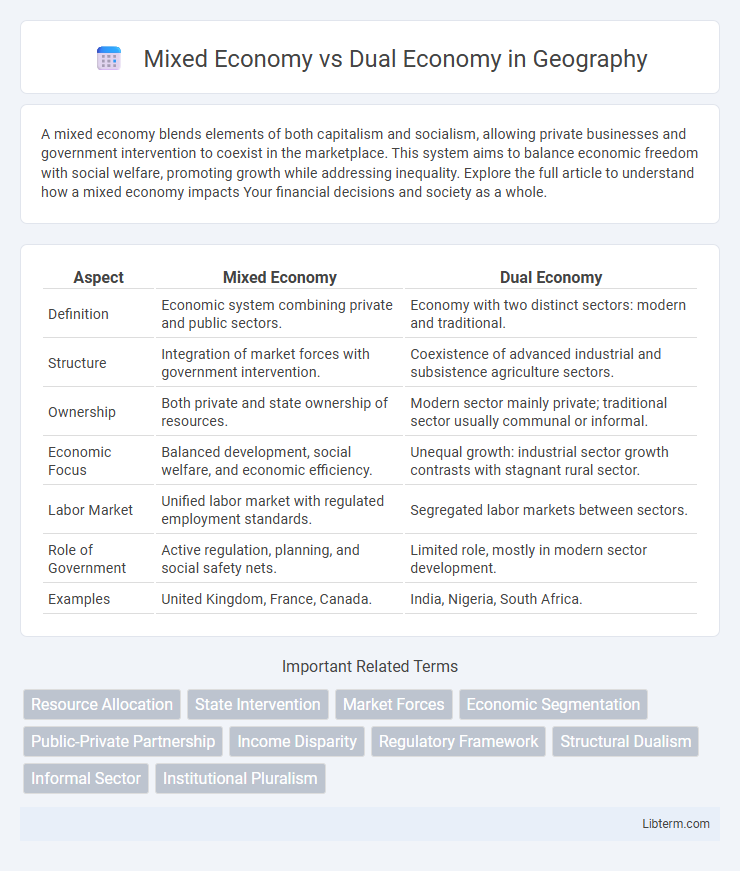A mixed economy blends elements of both capitalism and socialism, allowing private businesses and government intervention to coexist in the marketplace. This system aims to balance economic freedom with social welfare, promoting growth while addressing inequality. Explore the full article to understand how a mixed economy impacts Your financial decisions and society as a whole.
Table of Comparison
| Aspect | Mixed Economy | Dual Economy |
|---|---|---|
| Definition | Economic system combining private and public sectors. | Economy with two distinct sectors: modern and traditional. |
| Structure | Integration of market forces with government intervention. | Coexistence of advanced industrial and subsistence agriculture sectors. |
| Ownership | Both private and state ownership of resources. | Modern sector mainly private; traditional sector usually communal or informal. |
| Economic Focus | Balanced development, social welfare, and economic efficiency. | Unequal growth: industrial sector growth contrasts with stagnant rural sector. |
| Labor Market | Unified labor market with regulated employment standards. | Segregated labor markets between sectors. |
| Role of Government | Active regulation, planning, and social safety nets. | Limited role, mostly in modern sector development. |
| Examples | United Kingdom, France, Canada. | India, Nigeria, South Africa. |
Introduction to Economic Systems
Mixed economy combines characteristics of both capitalism and socialism, allowing private enterprise alongside government regulation to balance efficiency with social welfare. Dual economy describes a country with two distinct sectors--typically a modern, industrialized sector and a traditional, agricultural sector--highlighting disparities in development and income. Understanding these economic systems provides insight into how resources are allocated and income distribution is managed in different countries.
Defining Mixed Economy
A mixed economy combines elements of both market and planned economies, featuring private enterprise alongside significant government intervention to regulate and guide economic activity. It balances the efficiency and innovation of free markets with the social welfare objectives and redistribution policies typically associated with public sector control. This integration aims to optimize resource allocation, promote equitable growth, and reduce economic disparities inherent in purely capitalist or socialist systems.
Understanding Dual Economy
Dual economy refers to a socioeconomic system where two distinct economic sectors coexist within one country, often characterized by a modern, industrialized sector alongside a traditional, agricultural sector. This structure leads to significant disparities in income, productivity, and living standards between the two sectors, impacting overall economic development and resource allocation. Understanding dual economy dynamics is crucial for policymakers to design targeted interventions that bridge the gap between the modern and traditional sectors, fostering inclusive growth.
Key Features of Mixed Economies
Mixed economies combine elements of both capitalism and socialism, allowing private enterprise alongside government intervention to regulate market failures and promote social welfare. Key features include a balanced coexistence of private and public sectors, government planning to ensure equitable resource distribution, and social safety nets such as unemployment benefits and healthcare. This system aims to harness market efficiency while addressing economic inequality and providing public goods.
Core Characteristics of Dual Economies
Dual economies feature the coexistence of a modern industrial sector alongside a traditional agricultural sector, with stark disparities in productivity and income. The traditional sector often relies on subsistence farming and informal labor, while the modern sector employs advanced technology, capital investment, and skilled labor. This structural divide results in uneven development, persistent poverty in rural areas, and significant challenges in labor mobility and resource allocation.
Similarities Between Mixed and Dual Economies
Both mixed and dual economies incorporate elements of traditional and modern economic systems, blending market-driven approaches with varying degrees of government intervention. They exhibit coexistence of multiple sectors, such as informal and formal economies, or public and private enterprises, which address different societal needs. These economies aim to balance inequality and promote inclusive growth through diversified resource allocation and policy frameworks.
Major Differences: Mixed Economy vs Dual Economy
A mixed economy combines elements of both capitalism and socialism, allowing private enterprise alongside government intervention to regulate markets and ensure social welfare. In contrast, a dual economy is characterized by two distinct sectors--usually a traditional, subsistence agricultural sector and a modern, industrialized sector--with limited interaction between them. The major difference lies in the mixed economy's integrated market approach versus the dual economy's segmented structure leading to disparities in development and productivity.
Advantages and Disadvantages of Each System
Mixed economies combine private and public sector roles, promoting economic stability and reducing unemployment while allowing market flexibility; however, they may suffer from government intervention inefficiencies and regulatory complexities. Dual economies feature a modern industrial sector alongside a traditional agricultural sector, enabling rapid industrialization and export growth but often resulting in income disparity and structural unemployment. Each system balances economic growth and social equity differently, impacting overall development outcomes and resource allocation.
Real-World Examples and Case Studies
India exemplifies a mixed economy, combining private enterprise with significant government intervention in sectors like agriculture, manufacturing, and services, fostering balanced economic growth and social welfare. Conversely, Nigeria represents a dual economy, characterized by a modern industrial sector coexisting with a traditional agricultural sector, leading to disparities in income and development. Case studies reveal that mixed economies tend to achieve sustainable development through diversified economic activities, while dual economies struggle with structural inequalities hindering inclusive progress.
Conclusion: Choosing the Right Economic Model
Selecting between a mixed economy and a dual economy depends on a country's developmental goals, resource availability, and social priorities. Mixed economies provide balanced growth by integrating private enterprise with government intervention to address market failures and promote social welfare. Dual economies often highlight structural disparities between modern and traditional sectors, requiring targeted policies to bridge economic divides and ensure inclusive development.
Mixed Economy Infographic

 libterm.com
libterm.com